November 29, 2024 – Volume 26, Issue 11
In This Issue
- Flanigan’s Net Positive: Eagles and EV Tripping to Three Parks
- Ann Arbor Creates a Sustainable Energy Utility
- Swiss Roadway, Railroad, and Rooftop Solar
- BYD tops Tesla in EV sales
- Squatting for Bus Fares
- Vehicle-to-Home Virtual Power Plants
- Second-Life Batteries
- Travelogue Continued
- Flanigan’s Eco-Logic Podcast Updates
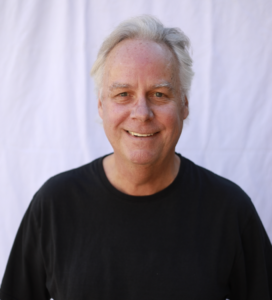
Flanigan’s Net Positive: Eagles and EV Tripping to Three Parks
A very special birthday indeed. Not my age but the venue: Front row balcony, the Sphere. Terry and I hit Vegas to see The Eagles. What we witnessed was an immersive concert spectacular! Without question this was the most memorable concert I’ve ever seen… topping Bob Marley at Tanglewood, the Stones in Anaheim, the Marshall Tucker Band at the Bottom Line, even Steve Morse and the Dixie Dregs at My Fathers Place in Roslyn.

We entered a virtual outdoor setting… complete with clear skies, waves lapping. Then a blimp floated overhead… pronounced with a timestamp to show how many minutes and seconds until the show begins. Then a countdown from the crowd: “Ten, nine, eight, seven, six, five, four, three, two, one…” Then at once, the virtual skies darken, a desert storm clashes to life.
Thunder and lightning take over the theater… and shortly thereafter the band rocks into Hotel California: “On a dark desert highway….” The entire screen becomes one with the song. Headlights are coming from far away, approaching from the Nevada desert… closer and closer. The audience gasps as the car overwhelms us, its bright headlights consume the theater, bright lights directly in our eyes, and then it veers off… and the song continues to the hotel, “Then she lit up a candle, and showed me the way!”
On stage, The Eagles are rooted by Don Henley, Joe Walsh, and Timothy B. Schmit. Vince Gill and Deacon Frye are now integral, shoring up the hole left by the band’s co-founder, Glenn Frye. The full band, backed by the legendary guitarist and 20-year band member Steuart Smith who has been with the Eagles since the 1990s, recreating the band’s iconic guitar sounds originally played by one of the early Eagles, Don Felder. Tonight, the Eagles are at their best for the current residency at the Sphere, following U2 and Dead and Company residencies. It’s a Vegas show-town thing, and this is the hottest ticket in Tinseltown.
An immersive experience indeed. Don Henley welcomed the crowd, quipping that, “We are the background music for the images.” A humble and false statement for a man with intense musical passion, a man as he put it, “playing in extra innings.” I was struck by his vocal energy, and passionate tones, and his drumming. And all this in my view was amplified with imagery, choreographed with the music… and the imagery is simply spectacular.

***
We left Vegas full of music, charged by The Eagles and the Sphere. Next up, EV road tripping, our longest battery electric trip. Off we were, ploughing past Vegas… through Nevada and Arizona, pioneering into the charging deserts of Utah. We visited Zion National Park, and then Bryce, then Death Valley on the way home. It’s a quick getaway, an EV challenge for us, and one night only view of three of the classic national park lodges.
Charging along the I-15 corridor is super easy and abundant. On the way to Vegas, there are multiple supercharging stations that rock… some with as many as 100 chargers! They are adorned with massive solar carports. We especially like the 100-charger facility at Tanger, its shade and clean restrooms. We charge at over 100 kW there. But off the main drag… we found charging deserts…. places where we had to resort to Level 2 at about 10 kW.
Learning to drive an EV is easy, navigating the charging infrastructure takes time to get used to. It’s pretty easy to find them. We’ve learned definitively that all chargers are not equal. Even when they are close to one another, they can be charging at different rates all measured in kilowatts. So we pick a charger, plug in and then check the charging rate. Then I ask around. For some reason, there is considerable difference. Furthermore, Tesla controls each cars’ charging rate, slowing down the rate when you attain 80%.
It’s an ice-breaking question. “What rate are you charging at?” I’ve met many nice folks this way. Then, “Where are you from/heading?” In Cedar City, Utah I fall in with a guy oh-so-proud of his new Cyber Truck. Immediately he invited me to sit in it, to take the wheel. Really? I could be a murderer! But I swing into the driver seat and meet his wife and dog. She smiles. He raves about the truck, its steer-by-wire system; its rear wheels that also steer.
For more on the travelogue… visiting Zion, Bryce, and Death Valley, read below.
Quote of the Month
“Last year the world invested $1.8 trillion in clean energy – more than was invested in fossil fuels – and installed 530 gigawatts of renewables. That’s 50% more capacity than the year before. And this year, we’ll continue the trend.”
Ann Arbor Creates a Sustainable Energy Utility

News to me… Perhaps “CCA-lite!” In the beginning, there were electric utilities… some owned by investors and others owned by the cities and farm communities they serve. These utilities own and operate power plants, they transmit power, and they distribute it in our communities, billing us monthly.
In addition to electric utilities, many states have enabled Community Choice Aggregators (CCAs). This form of utility sells us green power, or at least more of it! Where CCAs exist, their charges are included in our normal utility bills.
Now another form of utility – rooted in energy efficiency – is now coming into focus thanks to Ann Arbor, Michigan: the Sustainable Energy Utility, or SEU. Unlike Community Choice Aggregation utilities that must be enabled through state law, sustainable energy utilities can be activated locally.
The SEU model was developed by the Center for Energy and Environmental Policy at the University of Delaware. The model was first implemented by the State of Delaware, followed by the District of Columbia, Sonoma County in California, and the California Statewide Communities Development Authority. The SEU model has been recognized by the U.S. White House, the Asian Development Bank, and the International Energy Agency as a viable platform to spur sustainable energy investment while driving local economic development.
Delaware Sustainable Energy Utility (DESEU) is a nonprofit organization offering programs and resources to help residents save money through clean energy and efficiency. Created in 2007, it was the first of its kind in the United States. It has been replicated in other communities domestically and abroad. Its programs started with homes and now offers new ways for commercial and industrial and other nonresidential groups – including municipalities, universities, schools and hospitals — to become full partners in Delaware’s sustainable energy future.
DESEU offers audits, rebates, financing, low-interest loans, and grants. Its programs are strongly focused on providing access to clean energy and efficiency and savings for low-income customers. It also provides grants for large solar and geothermal systems. It is a self-funded initiative operated at no cost to taxpayers. It raises money through bond issuances – using tax exempt Sustainable Energy Bonds – also pioneered in Delaware — and pays money back through energy and cost-savings generated statewide.
Ann Arbor, Michigan has now voted to create a Sustainable Energy Utility, and has grand visions for its SEU. Just as Ann Arbor provides water and wastewater utilities, its new SEU will provide sustainable energy services. It is intended to be an accelerated pathway for the community to promote efficiency and clean energy to meet 2030 climate commitments. Functionally, participants will receive two separate utility bills, the normal one for the energy and associated services received from the local utility, DTE, and a new one for the energy and associated services received from the SEU.
The Ann Arbor Sustainable Energy Utility is an opt-in, supplemental community-owned energy utility that will provide energy from local solar and battery storage systems. It has its sights also on networked geothermal systems installed at participating homes and businesses in the City. Green energy will be provided to residents and businesses through direct installations on their properties as well as through small-scale distribution systems such as networked systems or microgrids.
The SEU benefits are huge: First and foremost is accelerating the transition to clean energy. Then there’s improved energy reliability at times when the grid goes down through increased access to solar and energy storage and shared geothermal systems. In Ann Arbor, there is a keen focus on equity. The SEU will deliver efficiency and weatherization programs for residents and businesses, even for those who don’t own their homes.
The vision is big: Microgrids serving neighboring households, where solar and storage are shared. On-bill financing to help lower the upfront costs and increase the flexibility of paying for appliance replacements and efficiency upgrades. District level geothermal systems so that neighbors can jointly tap into the earth to heat and cool their homes and businesses. Community solar programs that allow neighboring residents to invest and harvest the benefit from solar installed at community centers, in parks, or in shared areas around the City. Support for beneficial electrification and rebate programs to help people transition to cleaner and safer all-electric homes and businesses. Energy justice initiatives, including broad and deep access to renewable energy, the creation of programs for low income and underserved residents, workforce training opportunities, and the expansion of weatherization services.
Ann Arbor’s SEU allows the community to immediately start making progress on its 2030 decarbonization goals. It gives residents options now for services and results. It will begin with renewable energy and energy storage systems, microgrids, and robust efficiency programs. Later comes the design of networked and shared geothermal systems to provide sustainable heating and cooling.
Swiss Roadway, Railroad, and Rooftop Solar
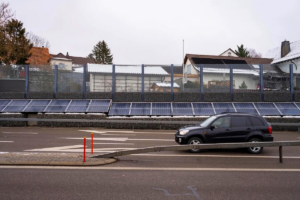
The Swiss government estimates an annual generation potential of 100 GWh of solar from noise barriers, half of those along the nation’s highways. Recently the government decided to make the surface of the barriers available free of charge. Last year, the Federal Roads Office known as Astra, put out a public tender to equip 350 roadside noise barriers with solar power, using part of the generation for its own needs along motorways. Similarly and nearby, Austria plans to reap 35 GWh of solar from its highway noise barriers by 2030.
The first two Swiss solar systems on the A15 Oberland Motorway, near Wangen-Bruttisellen, have now been approved and are expected to be completed in the first half of 2025. They will supply 500,000 kWh annually. They are built by private operators, in this case Lima Solar in collaboration with the Austrian Institute of Technology in Vienna, Focus Energie, and the Zindel Group.
Developers must meet certain conditions: First among them, the panels must not “dazzle” drivers with glare. Fortunately, demand for low-glare solar modules is rising, and their prices are dropping. Lima Solar is planning 50 additional noise barriers installations in the cantons of Zurich and Schaffhausen.
In closely related news, Sun-Ways has developed a way to install solar panels between the rails of railway systems in Switzerland. Getting permission to do so reportedly took a lot of effort. After ten months of building and testing, Sun-Ways secured the permits from the Federal Office of Transport. The International Union of Railways was worried that the panels may be prone to microcracks which could lead to an increased risk of fires. There have also been concerns about glare and reflections that might distract train drivers’ vision. Clean Technica reports that to maintain the panels’ effectiveness, brushes will be installed at the end of trains, clearing off any accumulated dirt. Sun-Ways has also designed a special railcar to install the panels. It can also uninstall them if there is a need for track repair.
In September of 2023, the Swiss government passed legislation that requires all new buildings with more than 3,300 square feet of roofs or facades to install solar on these surfaces. In 2024, the City of Zurich announced a new policy that requires solar panels on all large roofs. It applies to new roofs as well as substantially repaired or replaced roofs. The Swiss are working to fulfill the country commitment to the 2015 Paris Accord.
BYD Tops Tesla in EV Sales
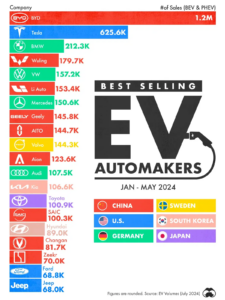
According to E Insider, from January through August of 2024, six of the top ten EV makers are Chinese. BYD has now topped Tesla as the number one EV maker in the world. BYD has now made over 10 million EVs, with sales surging to more than 500,000 per month… sales up 36.5% in 2024.
CleanTechnica reports that the BYD Denza Z9 has a tri-motor powertrain, one motor up front, the other two in the back. In China, its cost starts at $49,000. It comes in fully electric and PHEV models. The 100 kWh blade battery provides a 391-mile range. It has independent steering in each rear wheel.
Let’s put EV sales in perspective of the entire automotive industry. Of the 20 top selling automotive brands in 2023, here are some highlights:
1. Toyota with 9.4 million units made
2. Volkswagen, 5.3 million
3. Ford, 4.2 million
….
9. BYD – 2.9 million
15. Tesla, 1.8 million
Squatting for Bus Fares

In a town in Romania, you can do 20 squats and get a free bus pass. In a novel program in the City of Cluj-Napoka, a device measures the squats and when the number required is completed, voila… it prints a bus ticket. The Health ticket program initially ran for four months and resulted in more than a million squats valued at ~55,000 free bus tickets. Elderly and handicapped riders get free passes in this Transylvanian city.
The First Smart Sports bus station program aimed to prove a useful model, and to encourage the general public to find ways to introduce sports and movement into their daily routines. It was developed and sponsored by the Sports Festival which reimburses the local bus transit agency – CTP – for the free tickets. The project was originally carried out during European Sports Week, and now has been reintroduced given its success. Doing 20 squats results in a ticket that’s valid for a single trip on the City’s public transport network. Someone aptly noted that, It’s an out-of-the box currency to pay for bus fares.
Vehicle-to-Home Virtual Power Plants

Image Courtesy of Ford Motor Co.
Thanks to the U.S. Department of Energy, Baltimore Gas and Electric and Sunrun received a grant to launch one of the world’s first vehicle-to-home virtual power plants. Starting small with three vehicles, the “grid support program” uses Ford F-150 Lightning trucks to demonstrate how bidirectional electric vehicle charging can ease grid stress and add value for participating customers. The customer cohorts each own a F-150 and have a Ford Charge Station Pro and Home Integration System. With Ford, Sunrun co-developed this first commercially available bidirectional system.
Sunrun, which boasts that it is “the nation’s leading provider of clean energy as a subscription service,” developed and administered the program. Customers received payments based on the amount of energy they shared with the community, delivered to the grid during the “dispatch windows” from 5 – 9 pm on weekdays. Sunrun estimates customer payments of ~$800 over the four-month program.
In related news, BGE has been selected to receive up to $50 million in grant funding from the U.S. Department of Energy’s Grid Resilience and Innovation Partnerships Program. BGE’s Interconnection Readiness and Deployment of Storage Program endeavors to build 11 MW of battery energy storage solutions across BGE’s distribution system, in some cases requiring substation upgrades. The program also involves up to 3 MW of customer-owned solar + storage and electric vehicle charging stations.
Second-Life Batteries
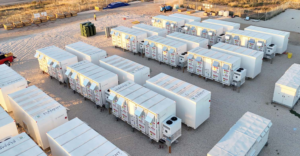
Image Courtesy of Element Energy
The Element Energy battery farm is now operational in Texas. The 53 megawatt-hour project is located in the western part of the State at a wind farm owned by Nextera Energy Resources. It came online in May. It is the world’s largest utility tied battery installation, eclipsing the B2U Storage Solutions’ project in Lancaster, California with 28 MWh of storage capacity.
Element Energy’s battery farm also bears another distinction: The entire installation is made with second-life batteries. Element Energy’s battery farm is made of battery packs that were once in electric vehicles. Element Energy projects 30-50% cost savings by using second-life batteries, and through its sorting and safe management of batteries. They degrade at different rates. Thus each battery cell is evaluated and managed according to its condition.
Element Energy is working in partnership with LG Energy Solutions which will package the batteries, and configure them to serve as a power plant, complete with inverters and auxiliary equipment. LG will be responsible for maintenance and operations of the energy storage systems through a technology using “cell-level battery controls.”
Travelogue Continued

Zion
Zion National Park… we’d never been there. Passed it many times. It is known for its dramatic geology, the intersection of three geographic provinces, the Colorado Plateau, the Great Basin, and the Mojave Desert. We proceed past a checkpoint to the lodge in the heart of the Park, and our rustic cabin there. The digs were certainly the polar opposite of the Wynn! Clean air, appreciative visitors, breathtaking views, great bus service… super frequent and convenient.
It’s raining, but we squeeze in a late afternoon hike up to the head of the canyon, to the trailhead for The Narrows. It’s a highly photographed gorge that’s only 20 feet wide in some places, with rock walls that soar up to 2,000 feet. Those that visit must walk upstream. We pass well-equipped trekkers completing their adventures, adorned with waders and boots provided by local outfitters. We’ll be back to do this in the warmth of summer.
The next day we had breakfast in the lodge and then headed out for the Emerald Pool trails. Easy trek to Lower Emerald Pools; a bit more effort to get to Upper Emerald Pool, surrounded on three sides by magnificent cliffs. I pass under Weeping Rock’s tears and then head down river.

Bryce
Some of us Southern Californians forget that there is such a thing as winter. We drove the short leg of our trip to Bryce Canyon National Park… and found it cold. A cold wind whipped and chilled us. I was woefully underprepared, a thin and insufficient fleece. It was dark by the time we found the Lodge at Bryce Canyon, the iconic lodge in the heart of the Park. It snowed that night.
We’d been really short on charge that afternoon. Terry’s search of the Tesla charging app found that there were a few Level 2 chargers near the Park, but nothing in the Park. I’d had a vision of our lodge having convenient chargers, or at least the Visitor’s Center having a few. It sports a really cool, dual-axis tracker PV array, but no chargers. We find two level 2 chargers in funky locations some miles away… one on a dirt alley bordering a hotel with pan abode cabins in the town of Tropic, with chargers mounted on a cement block wall. We plug in, take note of less than 10 kW charge and walk a few blocks to an overpriced general store. Its vegetables were a sorry sight.
Level 2 takes forever and we only charge about 20% there. Later that evening we hit the second charger, tucked in a dark alley behind a sprawling motel. Ice marked the spot too, but we charged another 20% while enjoying the best meal in that park entrance town. The next day, we wished that we’d stayed longer and gotten a bit more charge. We found out later that we were cutting it too close. Our battery was cold; the mountains unforgiving. It’s uncomfortable when your dashboard screen shows that you will arrive at the next charger with less than 5% charge. Once last year, we got down to 3%.
Bryce has an average elevation of ~8,000 feet. Bryce is not a single canyon, but a series of canyons and bowls carved into the Colorado Plateau. Bryce features the greatest number of “hoodoos” on Earth. Hoodoos are pillars that have been shaped by wind and water erosion, forming intriguing shapes. The most famous are in the Bryce Amphitheater, a short walk from the lodge. Its towering pillars appear to be a sea of people… huddled together to witness the sunrise and sunsets.
Some range anxiety as we leave the Park. Finally, an hour later, we come down a long grade and at last catch the I 15 corridor southwest to Beaver. By then our “tank” is very low, 4 – 5%. I’d been stressing out for an hour, especially towards the end when we had to climb a steep hill and I thought of our dwindling, precious-few kilowatt-hours. Again, I wished that I’d been more patient with the Level 2 charging. Forget about the claims of Teslas’ range. Sure, there are lots of variables but our extended range EV gets less than 200 miles when road tripping, less than 2/3s the advertised value. But thanks to diligent planning, we made it. We never “ran out of gas”, or missed it!
In fact, charging isn’t so bad. In fact, we’ve learned that it can be fun. You take a break, you stretch. In Beaver, we met a young couple charging their Model 3, nurses from Redlands, headed to see friends in Colorado. That’s road tripping. We fall into conversation about nursing, nursing homes, careers, the Menendez brothers, and more. What a fun and fulfilling 20-minute sync. We had to cut short our conversation as our wheels were ready to go! Only because of our EV did we have the chance to meet. My psychology professor Herb Leff would be proud… cognitive sets… not a time to gripe. These can be rich opportunities to meet new friends or do a bit of Tai Chi! I used another charging time in North Vegas to scour the car for trash and recycling. That purge felt good, the charge time productive.

Death Valley
Death Valley is in the northern Mojave Desert. Death Valley’s Badwater Basin is 282 feet below sea level, considered to be the lowest point in North America. Death Valley is just 86 miles as the crow flies from Mount Whitney, the highest point in the continental United States at 14,505 feet. Frank and I climbed that years ago. For Terry and I, the early November temperature was perfect for our Death Valley visit. That evening we sat out on a sweeping veranda watching the stars and feeling the enormity of the sacred valley.
Close to the Nevada border, and mostly in Inyo County, California, Death Valley is often the hottest place on Earth. Its name is derived from that deathly hot and dry geography. The Valley is in the rain shadow of four mountain ranges. Its hottest recorded temperature is 134 F, at Furnace Creek. In 1849 – 1850, a group of 13 pioneers got lost in Death Valley. They were looking for a shortcut to the goldfields of California. While only one member of the group died there, they had all assumed that they would, giving birth to Death Valley’s name.
We stayed at the classic lodge and indeed we did indeed find two chargers just waiting for us. We plugged in and breathed a sigh of relief. Those chargers are not on the Tesla app… and we had been very concerned about running out of charge here. In fact, we called the lodge and a welcoming receptionist told us that yes, they do have chargers that we are welcome to use. While not deathly hot at this time of year, it is miles and miles to the next town and tow truck. The hotel is an oasis… with gorgeous balconies and a naturally heated pool that I christen the next morning. Lots of character, one hundred years old.
Death Valley is the ancestral home of the Timbisha tribe of Native Americans. The tribe’s name comes from “tumpisa,” or rock paint. There’s a red ocher paint that can be made from a type of clay in the valley. Minerals later became a profound part of the Valley’s history. Prospectors mined gold and silver. To this day, one bears witness to lots of mines and lore. Borax was discovered, mined and extracted from the Valley on mule-train wagons.
What a great getaway. An amazing concert, then a taste of three parks… speed dating at Zion, Bryce, and Death Valley. Heading home, with plenty of time to regroup. We charged up in Mojave at just over 200 kW, our fastest charging of the trip. Another funky location. I cross the parking lot into our site host’s establishment to hit the loo. It’s a Weinerstube hotdog place. That’s off my diet! Kinda felt bad as I wanted to support the business that supports and hosts our EV charging.
Great times, lots of quality windshield time looking out and looking in. Lots of conversation threads over a six-day trip… from the Wynn and Sphere, to the cliffs at Zion and hoodoos at Bryce… from the moonscape of Death Valley. Relishing the Southwest. Getting a lot more used to charging. Planning the next charge. Being the change.
Flanigan’s Ego-Logic Podcast Updates

Use the links below to check out our recent podcasts. And you can always go to Spotify and type in “Ted Flanigan” to find our library of podcasts.
Recently Released:

In EcoNet News, Volume 26, Issue #11, Ted highlights his birthday trip to Vegas to see the Eagles play at the Sphere and shares his EV road tripping travelogue, hitting Zion National Park, Bryce, and Death Valley on his longest battery electric trip yet.
He also highlights Ann Arbor, Michigan creating a Sustainable Energy Utility (SEU), Swiss roadways, railroads, and rooftop solar, BYD topping Tesla in EV sales, squatting for bus fares in Romania, vehicle-to-home virtual power plants, and second-life batteries.
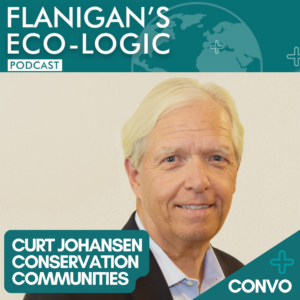
In this episode of Flanigan’s Eco-Logic, Ted speaks with Curt Johansen, a pioneer in conservation communities. He is the Development Director for Triad Communities, President of Council of Infill Builders, and has dedicated years to blending economic growth with environmental preservation. In his own words, he is advancing the art of finding balance between environmental protection, social responsibility, and economic prosperity.
Curt and Ted dive right into his work building out Lagoon Valley, the Bay Area’s First Conservation Community, where sustainability is not just a goal but a way of life. Curt oversees all aspects of community development, which features over 700,000 square feet of office space, an organic farm, wildlife preserve, 1,015 homes consisting of fourteen neighborhoods, ranging from affordable to age-qualified and executive housing, a vibrant Town Center, numerous parks, with over 70% of the Specific Plan area conserved for open space and recreational use.
He and Ted discuss the sustainable development principles that are at the core of the community. He emphasizes the importance of incorporating live, work, and play. He also mentions the conservation work and preservation that has been done and is unique to the community. This includes a golf course that will not only serve as a championship-level course, but will act as a fire and flood buffer for the area.
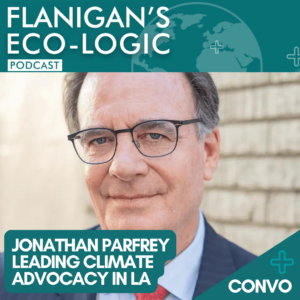
In this episode of Flanigan’s Eco-Logic, Ted speaks with Jonathan Parfrey, Founder and Executive Director at Climate Resolve, LA’s leading climate advocacy organization, committed to local climate solutions to reduce greenhouse gases and improve the lives of Angelenos. Jonathan highlights the actions Climate Resolve has taken to curb the heat island effect and keep LA cool.
He and Ted discuss LADWP’s dilemma (where Jonathan served as a commissioner from 2008-2013), and the tension of reaching 100% carbon free electric delivery by 2035, especially with the potential for using green hydrogen in peaker plants. They also discuss nonprofits’ role in electoral campaigns, specifically Climate Resolve’s stance on Proposition 4, and the best way to protect folks from heat waves.
Jonathan concludes by sharing the numerous plans that Climate Resolve has helped develop for LA, including the LA County Climate Vulnerability Assessment, the LA County Sustainability Plan, the Long Beach Climate Action and Adaptation Plan, the California Climate Adaptation Planning Guide, and the Fourth California Climate Change Assessment. He shares the difference between planning and implementation, and what his feelings are between the two approaches.

In this episode of Flanigan’s Eco-Logic, Ted speaks with Kameale Terry, co-founder and CEO of ChargerHelp!, a cutting-edge tech company launched in 2020 that tackles the issue of inoperable electric vehicle charging stations. Under her leadership, ChargerHelp! has raised over $21 million, amassed the nation’s largest dataset of EV service work orders, and services stations across 17 states.
Kameale formed ChargerHelp! with her co-founder Evette Ellis to create a reliable EV charging infrastructure. With the mission to leverage technology to promote economic mobility within all communities, ChargerHelp! uses data to identify and provide maintenance and repair services for EV charging stations.
Kameale’s innovative approach blends real-world data, predictive analytics, and machine learning to provide industry-leading solutions to ensure EV charging reliability. She is also deeply committed to workforce development, helping to create high-paying jobs through partnerships with organizations like the Society of Automotive Engineers and the U.S. Department of Labor. Her background in operations and technology, combined with her commitment to empowering historically marginalized communities, has positioned her as a thought leader in the clean energy and mobility sectors.
